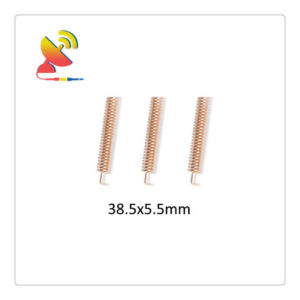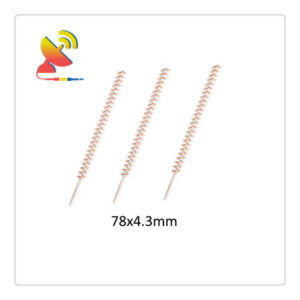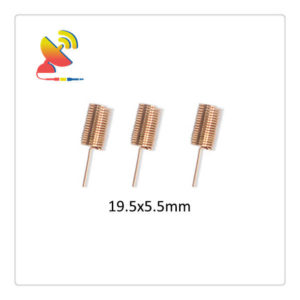Description
What is a 2×2 MIMO Antenna Omnidirectional 4G LTE Antenna?
The 2×2 MIMO Antenna CTRF-ANTENNA-FB-7027-72520-N-F Omnidirectional 4G LTE Antenna is a multi-band antenna with 2 ports LTE antenna omnidirectional waterproof fiberglass antenna manufactured by C&T RF Antennas Inc for indoor-outdoor Wireless Terminals.
The 4G LTE Smart MIMO Antenna High Gain Omni Directional Fiberglass Waterproof Antenna is a 2×2 MIMO dual boosting antenna for 3G and 4G networks.
The space-time processing technologies in the MIMO system mainly include beamforming, space-time coding, and space multiplexing.
Beamforming is a key technology in smart antennas, which improves the signal-to-noise ratio by directing the main energy to the desired user. Beamforming can effectively suppress co-channel interference, and the key is to determine the beamforming weight.
The 2×2 MIMO Antenna Omnidirectional 4G LTE Antenna is available at C&T RF Antennas Inc, the indoor 4G antenna and outdoor 4G antenna manufacturer in China.
C&T RF Antennas Inc provides internal & external antennas with the antenna radio frequencies such as NFC, 169MHz, 230MHz, 315MHz, 433MHz, 868MHz, 915MHz, VHF&UHF, Lora, NB-IoT, ADS-B, GSM, GNSS, Wifi 2.4GHz, 5.8GHz, Cellular 2G 3G 4G LTE, GPS, 5G NR, etc.
C&T RF Antennas Inc. provides RF antennae with Omni & Directional antenna types such as Dipole Antennas, Whip Antennas, Marine Antennas, Router Antennas, MIMO Antennas, Combo Antennas, PCB Antennas, FPC Antennas, Spring Antennas, Magnetic Antennas, Sector Antennas, Yagi Antennas, and Accessories, etc, for IoT & M2M industries.
Contact us for more details on the 2×2 MIMO Antenna such as 2×2 MIMO Antenna datasheet, 2×2 MIMO Antenna pricing, 2×2 MIMO Antenna inventory, or other 2×2 MIMO Antenna styles.
2×2 MIMO Antenna Omnidirectional 4G LTE Antenna Specifications
| 2×2 MIMO Antenna Omnidirectional 4G LTE Antenna Electrical Specifications | |
| RF Antenna Type | MIMO Antenna |
| Model | CTRF-ANTENNA-FB-7027-72520-N-F |
| Frequency Range | 698-960MHz, 1710-2700Mhz |
| Gain | 15dBi |
| VSWR | ≤2.0 |
| Impedance | 50 Ω |
| Polarization | Vertical |
| Directional | Omni-directional |
| Connector | N Female*2 |
| H-Beam & V-Beam | Hor:360; Ver:55 |
| Max Power | 50W |
| Lightning Protection | DC-Ground |
| 2×2 MIMO Antenna Omnidirectional 4G LTE Antenna Mechanical Specifications | |
| Dimension | 72*520mm |
| Weight | Approx. 2kg |
| Radome Material | Fiberglass |
| Operation Temperature | -20˚C ~ +85˚C |
| Storage Temperature | -40˚C ~ +80˚C |
| Color | Grey |
| Antenna Design | Dipole Array |
| Mounting | Screw/Pole |
| Safety Emission and other | RoHS Compliant |
| Applications | ISM/SCADA/Utilities, IoT/M2M/NB-IoT/LoRa, 2G 3G 4G LTE/LTE-IoT, GSM GPRS UMTS, etc. |
Smart MIMO Antenna
Smart antennas are usually called adaptive antenna arrays, which can form specific antenna beams to achieve directional transmission and reception and are mainly used to complete spatial filtering and positioning.
In essence, it uses the positional relationship between the elements in the antenna array, that is, the phase relationship of the signal to overcome multiple access interference and multipath interference. This is the essential difference between it and traditional diversity technology.
The MIMO system refers to a communication system that uses multiple antennas at the transmitter and receiver at the same time. It effectively utilizes random fading and possible multipath propagation to double the service transmission rate. Its core technology is a space-time signal
Smart antennas are usually called adaptive antenna arrays, which can form specific antenna beams to achieve directional transmission and reception and are mainly used to complete spatial filtering and positioning.
In essence, it uses the positional relationship between the elements in the antenna array, that is, the phase relationship of the signal to overcome multiple access interference and multipath interference. This is the essential difference between it and traditional diversity technology.
The MIMO system refers to a communication system that uses multiple antennas at the transmitter and receiver at the same time. It effectively utilizes random fading and possible multipath propagation to double the service transmission rate.
Its core technology is space-time signal processing, which uses a combination of multiple time domains and spatial domains distributed in space for signal processing. Therefore, it can be seen as an extension of smart antennas.
The smart antenna system has multiple antennas at the transmitting end/or receiving end of the mobile communication link.
Depending on whether the signal processing is located at the transmitting end or the receiving end of the communication link, the smart antenna technology is defined as multiple-input single-output (MISO) Single Output, Single Input Multiple Output, and Multiple Input Multiple Multiple-output.
How to use a high-gain fiberglass antenna?
In the construction of a wireless communication system, the omnidirectional fiberglass antenna is used as a repeater antenna. Is the gain or length of the fiberglass antenna the higher the better?
What are the characteristics of the specific FRP omnidirectional antenna, can it be used as an indoor antenna? Today I will talk to you about the omnidirectional fiberglass antenna.
Why are some fiberglass antennas not suitable for indoor use?
Many users believe that as long as the antenna gain is high, there is a strong communication quality, especially when there is a requirement to penetrate walls, so they are pursuing the absolute value of the antenna gain.
However, in indoor home or industrial routers, such as Huawei, the antenna selection is generally 2-5dBi, and high-gain antennas are rarely used.
This is because, on the one hand, high-gain antennas are generally large in size and inconvenient to install. On the other hand, high-gain omnidirectional antennas radiate omnidirectionally on the horizontal plane, but the radiation angle coverage on the vertical plane is very narrow (small lobe width).
The shorter communication range is counterproductive, so antennas with a gain of less than 8dBi are generally selected for indoor medium and short-distance coverage.
Why does the omnidirectional antenna also have a communication coverage angle?
An omnidirectional antenna means that the horizontal plane has no directivity, but as the gain increases, the antenna coverage on the vertical plane will become narrower (the lobe width is narrower), and the gain will reach 8dBi or more. The angle on the vertical plane will be less than 15 degrees.
With the radiation angle of the high-gain omnidirectional antenna lobe, the vertical angle becomes very narrow.
The transmitting and receiving range of the antenna. At the same location, 15dBi antennas are not as good as low-gain antennas. Case analysis of omnidirectional antennas with different gains.
When using a high-gain fiberglass antenna, you must pay attention to the radiation pattern of the fiberglass antenna, especially the vertical lobe width.
In the outdoors where the communication distance is extremely long, high-gain fiberglass antennas are usually used. At this time, the radiation angle on the vertical plane of the antenna will be very narrow, so the transmitting and receiving antennas are required to be in the same horizontal position as much as possible.
The height that the antenna needs to be erected can be calculated according to the required communication distance, coverage, and antenna lobe width, so as to ensure the communication quality of the high-gain antenna.
2×2 MIMO antenna fiberglass antenna features

2×2 MIMO antenna fiberglass antenna mounting ways

2×2 MIMO antenna fiberglass antenna applications







Reviews
There are no reviews yet.